Banner Year for Neural Technology
- Share via
Nagy, a strapping tomcat, sports a little white backpack, and the wires that emerge from it plug into the top of his head. He seems serene, cuddling his master like a normal house cat, even though a steady stream of electrical pulses is flowing through the apparatus and stimulating a nerve in his brain.
His masters say Nagy doesn’t feel a thing. Pain, in fact, would ruin the experiment. And he and about 30 other felines at the Huntington Medical Research Institutes in Pasadena are at the forefront of a decades-long effort to develop a new genre of treatments for neurological diseases and injuries--an effort that is now yielding some life-altering breakthroughs.
In July, the Food and Drug Administration granted approval for a Texas company to begin marketing a treatment for epilepsy that relies on direct stimulation of nerves via electrical implants. In August, it gave the go-ahead for an electrical implant to suppress tremors in Parkinson’s disease sufferers. A method for restoring arm movement in some quadriplegics also got the green light this year.
“This is a banner year for this discipline,” says William F. Agnew, director of the neurological research laboratory at Huntington. “Three [applications] passed [the FDA approval process] after 30 years of research. It’s very gratifying for us.”
There’s a lot more in the pipeline, including a system that might allow paraplegics to have sex and conceive children. Decades from now, what’s known as neural prosthesis technology could restore sight for the blind, and even make it possible to control artificial limbs with the mind.
Although a few medical devices that use electrical implants--notably cardiac pacemakers and cochlear implants to restore hearing--have been around for years, researchers agree that we’ve only just begun to see what’s possible.
The journey from promising idea to marketable product is a brutal one in this field, and some grumble that it takes a lot longer than it should. But the relationship among Huntington, the federal government and private industry in developing neural prosthesis technology shows a system for supporting medical innovation that’s working pretty well.
The National Institutes of Health has been sponsoring neural prosthesis research since 1971, spending $6 million annually in its own labs and on contracts with private labs such as Huntington.
That taxpayer-funded basic research, in turn, has served as a resource for the private sector, where specific treatments have been developed by small start-up companies and big biomedical firms alike. The FDA has been demanding in its approval process, but given the potentially dangerous nature of the technology, that seems appropriate.
The basic concept behind neural prostheses--that electrical stimulation of nerves can induce certain reactions in the body--dates all the way back to Ben Franklin, who thought electricity might cure paralysis. F. Terry Hambrecht, head of neural prosthesis research at the NIH, says contemporary work began in earnest in 1968, when an English researcher showed that implanting electrodes could enable a blind person to see spots of light.
Huntington--a private research laboratory affiliated with Huntington Memorial Hospital--was among the first group of NIH contractors in the field. Agnew’s team was charged with understanding the basic physiology of electrical nerve stimulation and developing the electrodes that would make it possible.
Using cats as test subjects--they have a nervous system structure similar to humans’--the researchers began a long process of determining how electrical pulses affect tissue, what level of electricity achieves the desired result and how responses might change over time.
The electrodes must be able to deliver the charge to a very precise area. Some, such as the one used for the epilepsy treatment, actually wrap around the nerve. Others plug into the nerve tissue with tiny prongs. All must use special materials--platinum and iridium turn out to be especially effective--so that they don’t poison the recipient, or decay.
At the nondescript, four-story Pasadena lab building, technicians work with microscopes to create the tiny electrodes. Scientists collect data from cats with electrodes implanted, and examine the effects of electrodes that have been in place for a long time.
Cyberonics, a Webster, Texas, company, is among the beneficiaries of that work. The firm was founded in 1987 by Reese Terry, an engineer who had been involved in research on nerve stimulation at a firm called Intermedics and saw a business opportunity when that company decided to drop the work. Animal research at Intermedics had shown that stimulation of a major nerve known as the vagus could suppress epileptic seizures.
“The real key to this was, how do you make an electrode to stimulate a nerve without damaging it,” Terry says. “We went to the NIH, and they said Huntington had the best electrodes.”
Initially, the research institute supplied the electrodes, and later licensed its designs to Cyberonics. Over the course of a decade, Cyberonics refined its technology and carried out the long series of trials required to get FDA approval--spending $50 million in the process.
The treatment includes an electrode that coils around the vagus nerve in the neck, and an electrical pulse generator that’s implanted under the skin. There are about 190,000 epilepsy sufferers in the U.S. who are candidates for the $15,000 treatment.
The time and expense of gaining FDA approval has limited the range of competitors in the neural prosthesis area, says Terry. St. Jude Medical, one of the nation’s largest such firms, once had an option to buy Cyberonics but passed, though it still holds an equity stake.
But Minneapolis-based Medtronic, the leader in pacemakers, has pushed ahead. For some years, the company has been marketing a pain treatment system that relies on electrical jolts to the spinal cord, and it’s now selling a brain implant for treating Parkinson’s tremors.
The company hopes soon to be able to treat other Parkinson’s symptoms, and has high hopes for the whole field. An FDA panel recently recommended approval of a Medtronic treatment that would enable quadriplegics to control urination.
“We’re going to see a real explosion in the use of electrical stimulation,” says Medtronic spokeswoman Jessica Stoltenberg.
Huntington, meanwhile, is wrestling with how best to exploit its technologies. Randy Carter, a scientist with some business expertise--he runs an energy-brokering business with his wife on the side--has been charged with examining whether the institute should try to spin off a company to sell the electrodes.
That would certainly fit with some of the grander plans of Huntington Executive Director William Opel, who hopes to help develop Pasadena into a major medical technology center. Plans are underway for an incubator that might help biomedical businesses grow out the research done at Huntington, Caltech and other local hospitals and research institutions.
“We want to retain more of these tech companies, instead of seeing them go off to Santa Barbara or Texas,” says Opel.






